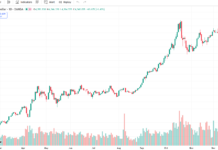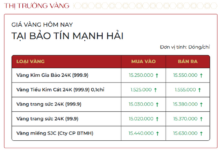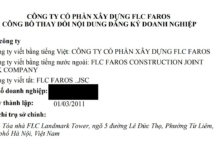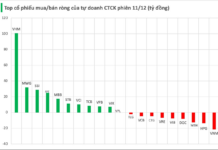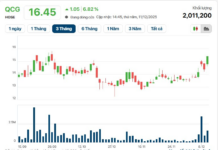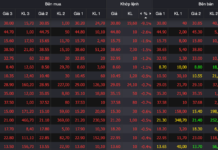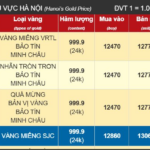Mr. Nguyen Quang Huy, CEO of Finance and Banking at Nguyen Trai University, predicts that gold prices in Vietnam are unlikely to drop immediately in the short term. He attributes this to the strong trust in the SJC gold brand, and believes that new brands will need time to prove their quality and liquidity.
“Market dynamics will keep prices high in the short to medium term. The psychological refuge of gold during global fluctuations, coupled with limited physical supply in Vietnam, will sustain elevated price levels. Over the medium to long term, as more gold becomes available from banks and enterprises, the gap between domestic and global prices will narrow, and the market will move towards a more balanced scenario,” Mr. Huy added.
He also highlighted the significance of ending the monopoly on gold bar production, marking a significant turning point towards a competitive landscape rather than the previous SJC monopoly.
“With this new regulation, the entry of commercial banks and qualified enterprises into the market will gradually improve the supply of gold bars, paving the way for a less distorted, more transparent, and internationally aligned market,” Mr. Huy explained.
However, Mr. Huy cautioned that these effects will be felt in the long term, and the market is unlikely to witness immediate changes in the short term due to the time required for licensing procedures, production, and establishing trust.

Experts predict that gold prices are unlikely to drop immediately in the short term. (Photo: Minh Duc).
Meanwhile, gold expert Tran Duy Phuong offered a different perspective, noting that it will take over a month for the Government’s Decree No. 232 to come into effect. This period is expected to involve preparations for the issuance of guiding circulars and provide time for related units to make necessary calculations and arrangements.
According to Mr. Phuong, a significant impact on the gold market will only be felt when enterprises are allowed to import gold materials, produce gold, and increase supply in the market, leading to a noticeable cooling-off in prices.
“A strong market fluctuation is likely to occur from the beginning of November onwards, with the price gap potentially narrowing from nearly VND 20 million per tael to VND 12-13 million per tael,” Mr. Phuong predicted.
Regarding the possibility of domestic gold prices dropping to the VND 100 million per tael mark, Mr. Phuong shared that with the international gold price at USD 3,370 per ounce, the corresponding domestic price would be around VND 114-115 million per tael.
For Vietnamese gold prices to fall to the VND 100 million level, the world gold price would need to drop by about USD 300 to the USD 3,000-3,050 per ounce range.
“The determining factor remains the movement of international gold prices,” he emphasized.
Mr. Phuong also pointed out numerous factors that could push down international gold prices, including improved geopolitical stability and progressing trade negotiations between the US and its partners.
“Investors should consider injecting money into gold when the price gap between international and domestic gold prices narrows to VND 5-7 million per tael, which is a reasonable differential,” Mr. Phuong advised.
Multiple measures are needed to increase gold supply
Dr. Nguyen Tri Hieu, an economist, believes that the gold market will undergo significant changes, provided that the decree is swiftly implemented and not just a policy on paper.
According to Dr. Hieu, without concrete actions such as declaring that the SJC gold brand is no longer the national brand or allowing commercial banks to import gold, the gold market is unlikely to witness significant transformations.
He analyzed that with the new regulations, domestic gold prices could drop by VND 5-10 million per tael, but only if international gold prices remain stable. If international prices continue to rise, domestic prices will follow suit.
Additionally, Dr. Hieu emphasized the need to enhance the management of the gold market with the introduction of multiple gold bar products. Up until now, the State Bank of Vietnam has primarily been responsible for market management. However, gold is essentially a precious commodity rather than a currency, falling outside the scope of monetary policy and the direct authority of the State Bank.
Therefore, Dr. Hieu suggested considering the establishment of a specialized agency for gold market management, independent from the State Bank. This agency would be tasked with stabilizing prices, regulating supply and demand, narrowing the gap between domestic and international gold prices, controlling transactions, curbing smuggling, and overseeing all gold business activities.
Meanwhile, Prof. Dr. Nguyen Huu Huan from the University of Economics Ho Chi Minh City, pointed out that for enterprises to produce gold bars, they would require a source of gold material, which means that the State Bank would need to allocate import quotas. The adequacy of these quotas will be a critical factor in determining the ability to narrow the gold price gap.
“Ending the monopoly is necessary but not sufficient. To stabilize the gold market, comprehensive and synchronized solutions are needed, especially addressing the root cause of the gold supply issue,” Prof. Huan emphasized.
Additionally, Prof. Huan suggested developing a gold exchange within the framework of the international financial centers that are being prepared for construction. This exchange would help curb speculation by shifting trading activities from physical gold to financial transactions, thereby reducing the demand for holding physical gold.
Furthermore, Prof. Huan proposed mobilizing gold from the people through tokenization or the issuance of gold certificates. Depositors would receive a low-interest rate of around 0.5-1% per annum but would be assured of the safety of their gold. The State could then utilize these resources for development investments. To protect the value of the mobilized gold, the State Bank should apply derivative tools to prevent gold price fluctuations.
Gold expert Tran Duy Phuong reiterated that a substantial impact on the market will only be felt when enterprises are permitted to import gold materials, produce gold, and increase supply, leading to a noticeable cooling-off in prices.
The Golden Opportunity: From Gold to the New Investment Craze
The long queues outside gold shops in Ho Chi Minh City have led to a creative shift in investment strategies. With only a limited amount of gold being purchased, often just a fraction of what people desire, the focus has now turned to silver. This new investment avenue offers a distinct advantage with its affordable pricing and abundant supply.
The Golden Monopoly is Over: When Will Prices Drop?
According to experts, the elimination of the gold bullion monopoly will not lead to an immediate decrease in gold prices in the short term. There will be a certain lag before prices adjust.
“Decree 232: Safeguarding Public Interests, Marching Towards a Transparent Gold Market”
As of late August 2025, the domestic gold price witnessed a complex upward trajectory. By August 29, 2025, SJC gold bars had surged past VND 129 million per tael, while gold rings had also climbed above VND 123 million per tael.






